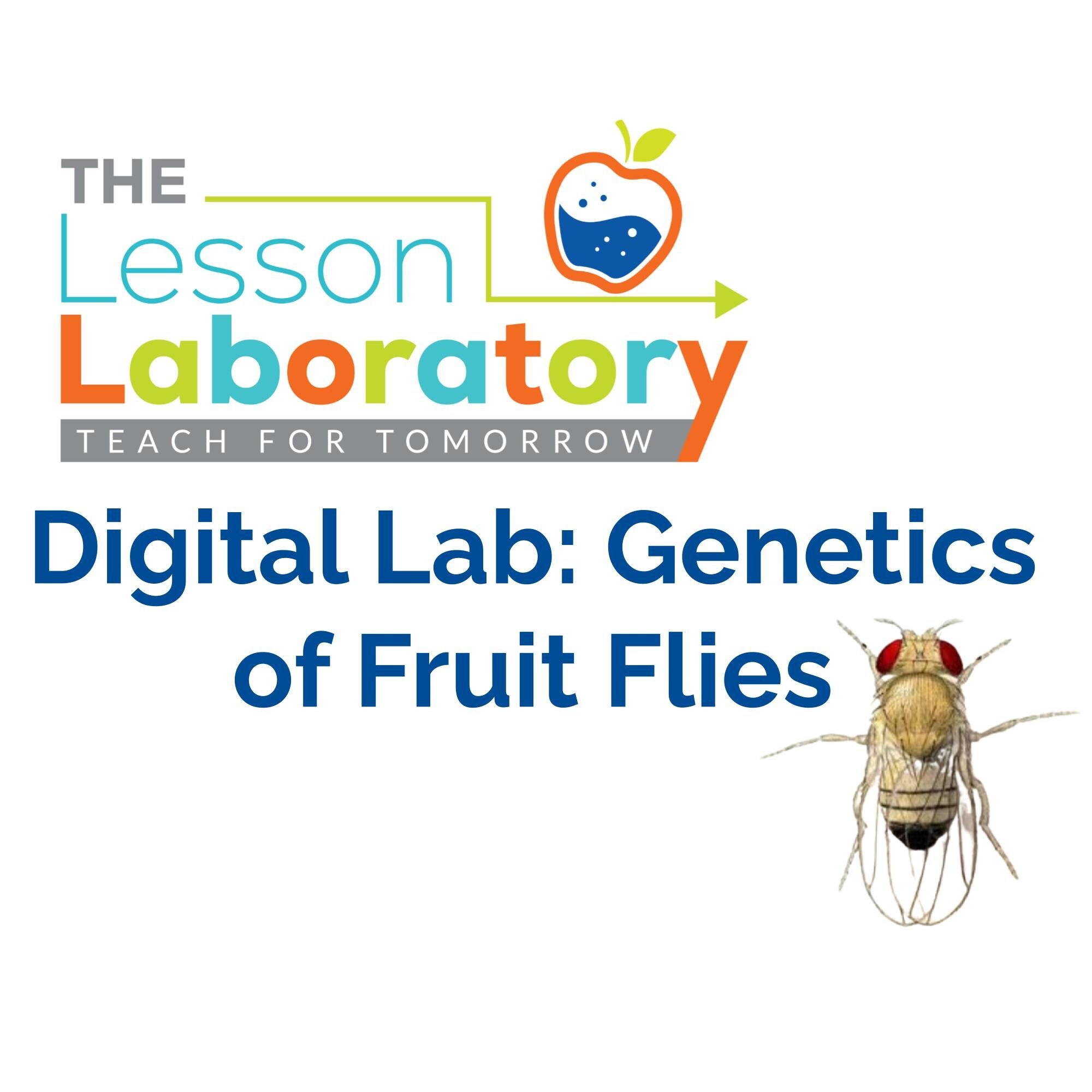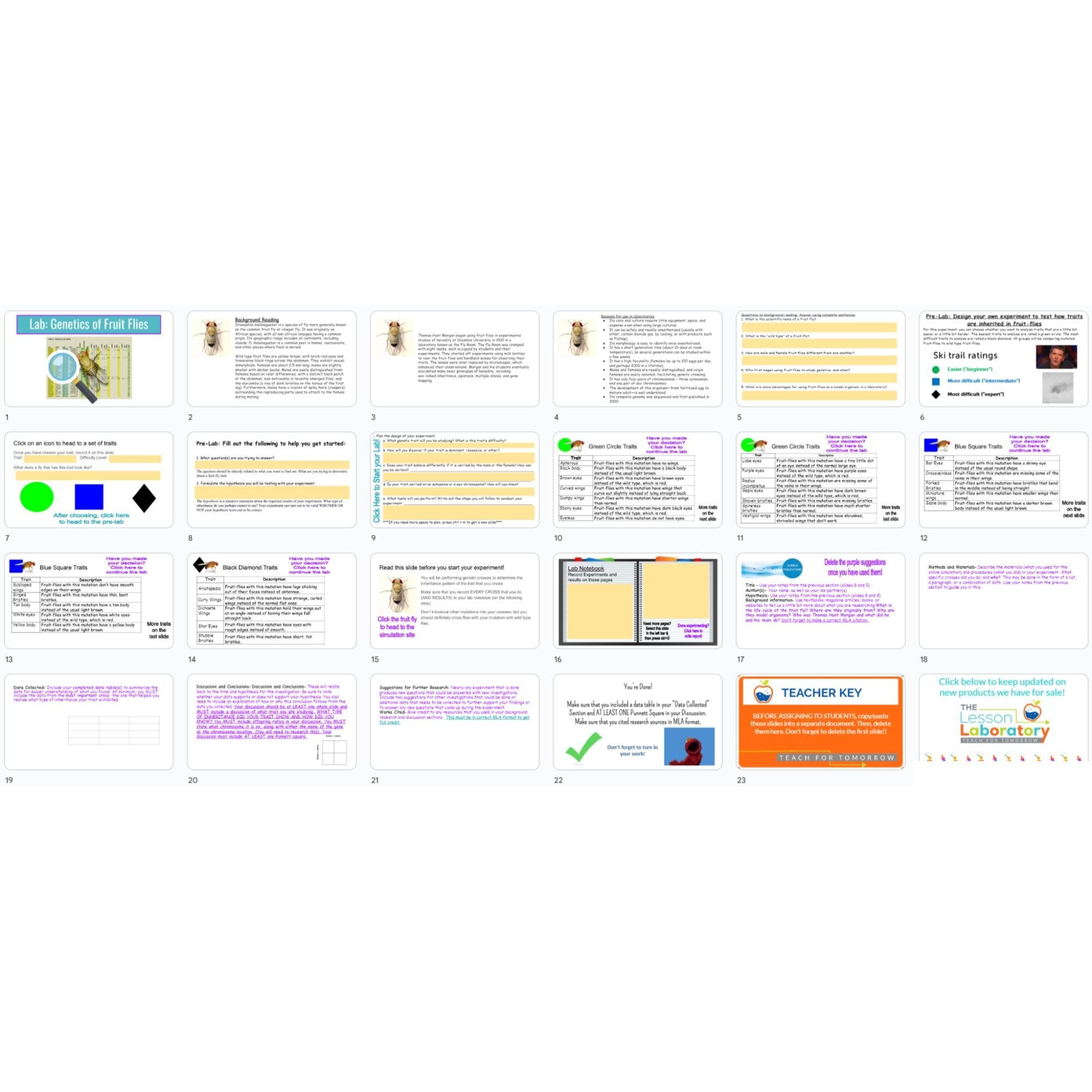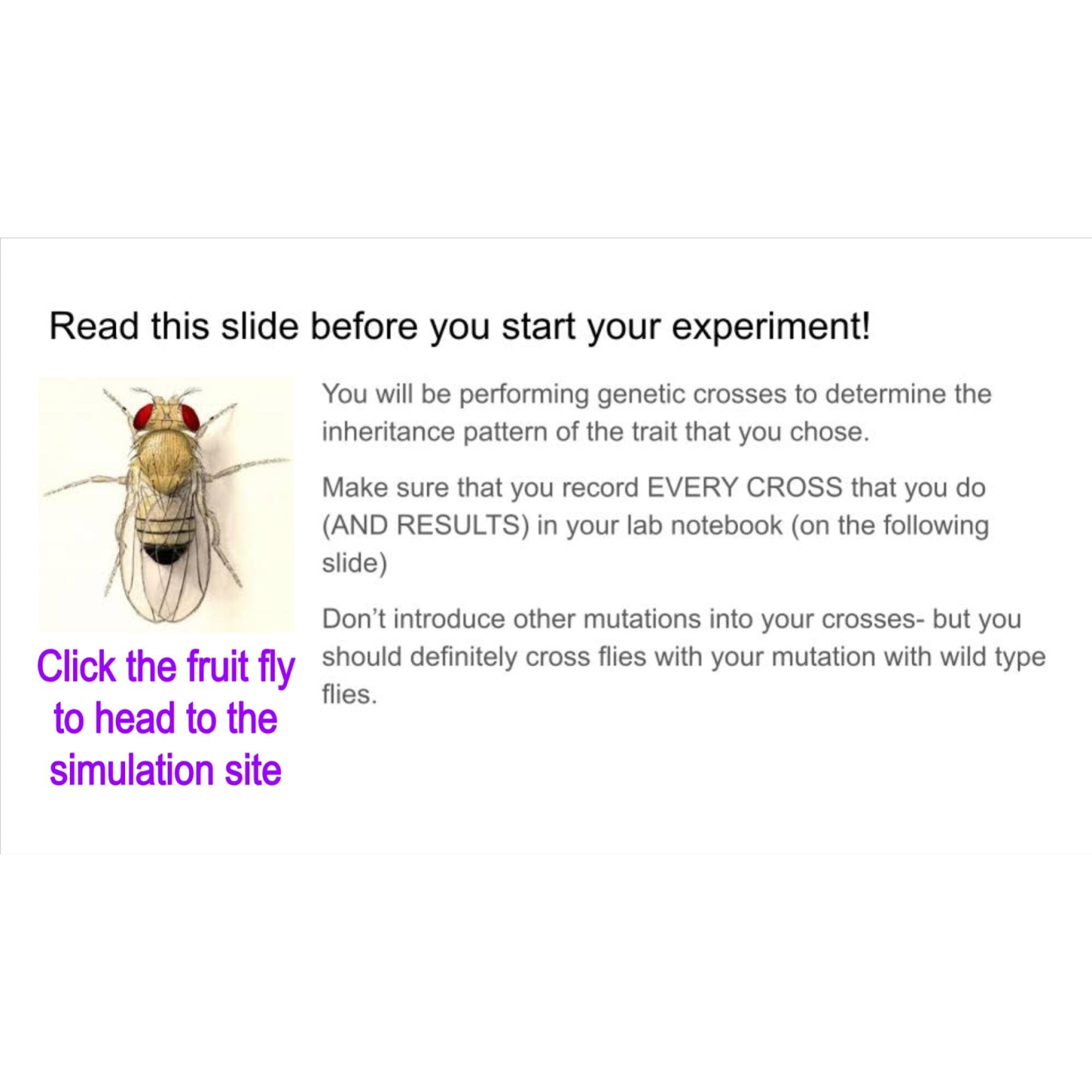 Image 1 of 4
Image 1 of 4

 Image 2 of 4
Image 2 of 4

 Image 3 of 4
Image 3 of 4

 Image 4 of 4
Image 4 of 4





Digital Lab: Genetics of Fruit Flies
Embark on a Genetic Exploration with this Digital Fruit Fly Lab!
🪰 Unraveling Inheritance Patterns: This seamlessly crafted lab empowers students to investigate the inheritance pattern of a fruit fly trait through genetic crosses, employing an intuitive online simulator. Tailored for student-directed differentiation, it offers a dynamic learning experience.
🧬 Step-by-Step Learning Journey:
Background Reading and Questions: Students dive into the lab by completing a background reading, followed by thought-provoking questions that set the stage for their genetic exploration.
Student-Driven Differentiation: Empowering students with choice, they embark on a journey based on their preferred difficulty level. Like selecting ski trails, they opt for a beginner (green circle), intermediate (blue square), or expert (black diamond) trait category. This choice leads them to a selection of intriguing traits, allowing them to choose the one that sparks their curiosity.
Pre-Lab Planning: Students proactively plan their approach by outlining the questions they aim to address and designing the crosses that will aid in their investigation.
Virtual Crosses with Online Simulator: Using the online simulator, students perform test crosses on fruit flies. They meticulously record their results in the provided lab notebook, ensuring a comprehensive exploration.
Guided Lab Report Writing: To facilitate their lab report, students receive a scaffolded framework with pre-established headings and supportive suggestions (indicated in purple). This helps them initiate their report, and they can easily modify or remove the prompts as needed.
🔍 Why Choose This Lab?
🪰 Engaging Simulation: Students interact with a virtual fruit fly simulator, bringing genetics to life in a captivating manner.
📚 Student-Centered Differentiation: Tailored difficulty levels empower students to choose a trait that aligns with their interests and comprehension level.
📝 Scaffolded Lab Report: The provided structure and prompts support students in crafting a comprehensive lab report.
🚀 Seamless Integration: Designed on Google Slides, it ensures easy access and compatibility for both educators and students.
👩🔬 Ignite Genetic Curiosity: Equip your students with invaluable knowledge about inheritance patterns. Download this digital lab now and watch their scientific understanding flourish!
To preview this product, highlight the link below and paste the address into your web browser.
https://docs.google.com/presentation/d/1-Zr3y3gyCVTHIo8RjKQJmDkstzbx2cLAgCVdVd4Xpx0/edit?usp=sharing
Grade & Course Recommendation:
Middle School: Enrichment lab for Grade 8 honors life science.
High School: Grade 9–10 Biology, hands-on genetics or inheritance investigation.
Cross-Curricular Connections:
Math Integration: Statistical analysis and probability through Punnett ratios.
Technology Integration: Potential use of digital fly simulation software.
ELA Integration: Students compose written lab analyses using evidence-based reasoning.
Join the Lesson Laboratory and Teach for Tomorrow!
NGSS (Next Generation Science Standards)
HS-LS3-1: Ask questions to clarify relationships about the role of DNA and chromosomes in coding the instructions for characteristic traits passed from parents to offspring.
Connection: Students use simulated crosses to explore how specific mutations are inherited.HS-LS3-2: Make and defend a claim based on evidence that inheritable genetic variations may result from new genetic combinations through meiosis, errors during replication, and/or mutations.
Connection: Students analyze simulation data to determine inheritance patterns and defend their conclusions.HS-LS3-3: Apply concepts of statistics and probability to explain the variation and distribution of expressed traits in a population.
Connection: Students use offspring ratios and Punnett squares to calculate probabilities and interpret inheritance outcomes.Science and Engineering Practices: Analyzing and interpreting data; Constructing explanations; Engaging in argument from evidence.
Crosscutting Concepts: Cause and effect; Patterns; Systems and system models.
Common Core Standards
CCSS.ELA-LITERACY.RST.9-10.1 / RST.11-12.1: Cite specific textual evidence to support analysis of scientific information. (connection: supporting inheritance claims with data from the simulation)
CCSS.ELA-LITERACY.RST.9-10.3 / RST.11-12.3: Follow precisely a complex multistep procedure when carrying out experiments or simulations.
CCSS.ELA-LITERACY.RST.9-10.7 / RST.11-12.7: Integrate quantitative or technical information expressed in words with visual data (Punnett squares, offspring ratios).
CCSS.ELA-LITERACY.WHST.9-10.2 / WHST.11-12.2: Write informative/explanatory texts, including scientific analyses and conclusions.
CCSS.ELA-LITERACY.WHST.9-10.8 / WHST.11-12.8: Gather relevant information from multiple authoritative print and digital sources, using advanced searches effectively. (connection: using research sources for background and works cited sections)
CCSS.ELA-LITERACY.WHST.9-10.9 / WHST.11-12.9: Draw evidence from informational texts to support analysis, reflection, and research.
Embark on a Genetic Exploration with this Digital Fruit Fly Lab!
🪰 Unraveling Inheritance Patterns: This seamlessly crafted lab empowers students to investigate the inheritance pattern of a fruit fly trait through genetic crosses, employing an intuitive online simulator. Tailored for student-directed differentiation, it offers a dynamic learning experience.
🧬 Step-by-Step Learning Journey:
Background Reading and Questions: Students dive into the lab by completing a background reading, followed by thought-provoking questions that set the stage for their genetic exploration.
Student-Driven Differentiation: Empowering students with choice, they embark on a journey based on their preferred difficulty level. Like selecting ski trails, they opt for a beginner (green circle), intermediate (blue square), or expert (black diamond) trait category. This choice leads them to a selection of intriguing traits, allowing them to choose the one that sparks their curiosity.
Pre-Lab Planning: Students proactively plan their approach by outlining the questions they aim to address and designing the crosses that will aid in their investigation.
Virtual Crosses with Online Simulator: Using the online simulator, students perform test crosses on fruit flies. They meticulously record their results in the provided lab notebook, ensuring a comprehensive exploration.
Guided Lab Report Writing: To facilitate their lab report, students receive a scaffolded framework with pre-established headings and supportive suggestions (indicated in purple). This helps them initiate their report, and they can easily modify or remove the prompts as needed.
🔍 Why Choose This Lab?
🪰 Engaging Simulation: Students interact with a virtual fruit fly simulator, bringing genetics to life in a captivating manner.
📚 Student-Centered Differentiation: Tailored difficulty levels empower students to choose a trait that aligns with their interests and comprehension level.
📝 Scaffolded Lab Report: The provided structure and prompts support students in crafting a comprehensive lab report.
🚀 Seamless Integration: Designed on Google Slides, it ensures easy access and compatibility for both educators and students.
👩🔬 Ignite Genetic Curiosity: Equip your students with invaluable knowledge about inheritance patterns. Download this digital lab now and watch their scientific understanding flourish!
To preview this product, highlight the link below and paste the address into your web browser.
https://docs.google.com/presentation/d/1-Zr3y3gyCVTHIo8RjKQJmDkstzbx2cLAgCVdVd4Xpx0/edit?usp=sharing
Grade & Course Recommendation:
Middle School: Enrichment lab for Grade 8 honors life science.
High School: Grade 9–10 Biology, hands-on genetics or inheritance investigation.
Cross-Curricular Connections:
Math Integration: Statistical analysis and probability through Punnett ratios.
Technology Integration: Potential use of digital fly simulation software.
ELA Integration: Students compose written lab analyses using evidence-based reasoning.
Join the Lesson Laboratory and Teach for Tomorrow!
NGSS (Next Generation Science Standards)
HS-LS3-1: Ask questions to clarify relationships about the role of DNA and chromosomes in coding the instructions for characteristic traits passed from parents to offspring.
Connection: Students use simulated crosses to explore how specific mutations are inherited.HS-LS3-2: Make and defend a claim based on evidence that inheritable genetic variations may result from new genetic combinations through meiosis, errors during replication, and/or mutations.
Connection: Students analyze simulation data to determine inheritance patterns and defend their conclusions.HS-LS3-3: Apply concepts of statistics and probability to explain the variation and distribution of expressed traits in a population.
Connection: Students use offspring ratios and Punnett squares to calculate probabilities and interpret inheritance outcomes.Science and Engineering Practices: Analyzing and interpreting data; Constructing explanations; Engaging in argument from evidence.
Crosscutting Concepts: Cause and effect; Patterns; Systems and system models.
Common Core Standards
CCSS.ELA-LITERACY.RST.9-10.1 / RST.11-12.1: Cite specific textual evidence to support analysis of scientific information. (connection: supporting inheritance claims with data from the simulation)
CCSS.ELA-LITERACY.RST.9-10.3 / RST.11-12.3: Follow precisely a complex multistep procedure when carrying out experiments or simulations.
CCSS.ELA-LITERACY.RST.9-10.7 / RST.11-12.7: Integrate quantitative or technical information expressed in words with visual data (Punnett squares, offspring ratios).
CCSS.ELA-LITERACY.WHST.9-10.2 / WHST.11-12.2: Write informative/explanatory texts, including scientific analyses and conclusions.
CCSS.ELA-LITERACY.WHST.9-10.8 / WHST.11-12.8: Gather relevant information from multiple authoritative print and digital sources, using advanced searches effectively. (connection: using research sources for background and works cited sections)
CCSS.ELA-LITERACY.WHST.9-10.9 / WHST.11-12.9: Draw evidence from informational texts to support analysis, reflection, and research.